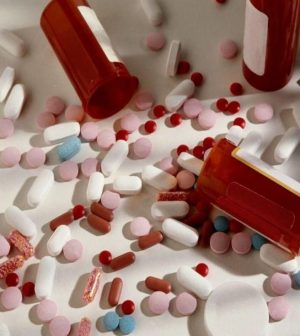- Navigating Your Midlife Crisis: Embracing New Possibilities
- City Raccoons Showing Signs of Domestication
- Mapping the Exposome: Science Broadens Focus to Environmental Disease Triggers
- One Week Less on Social Media Linked to Better Mental Health
- Your Brain Changes in Stages as You Age, Study Finds
- Some Suicide Victims Show No Typical Warning Signs, Study Finds
- ByHeart Formula Faces Lawsuits After Babies Sickened With Botulism
- Switch to Vegan Diet Could Cut Your Greenhouse Gas Emissions in Half
- Regular Bedtime Does Wonders for Blood Pressure
- Dining Alone Could Mean Worse Nutrition for Seniors
India’s COVID Crisis Could Spawn Another: Antibiotic Misuse

While COVID-19 surged in India, so did the overuse or widespread misuse of antibiotics — risking a future threat of drug-resistant bacteria.
Antibiotic sales soared during India’s first wave of COVID, suggesting the drugs were used to treat mild and moderate cases. That runs counter to guidelines for the medications.
“Antibiotic resistance is one of the greatest threats to global public health,” said study senior author Dr. Sumanth Gandra, an associate professor at Washington University School of Medicine in St. Louis.
The study was conducted in collaboration with McGill University in Montreal, Canada.
“Overuse of antibiotics lessens their ability to effectively treat minor injuries and common infections such as pneumonia, which means that these conditions can become serious and deadly,” Gandra said in a university news release. “Bacteria that have become resistant to antibiotics don’t have boundaries. They can spread to any person in any country.”
In high-income countries such as the United States, United Kingdom and Canada, overall antibiotic use plunged in 2020, even during COVID-19 peaks. India’s uptick indicates that COVID guidelines were not followed, Gandra said.
Antibiotics are only effective against bacterial infections, not viral infections. India has had nearly 400,000 deaths and 30 million cases of COVID, though some experts suspect the actual numbers are much higher. With 1.4 billion people, India is the world’s second most-populous country and largest consumer of antibiotics.
In India, an unregulated private sector accounts for 75% of health care and 90% of antibiotic sales, Gandra said.
For the study, researchers analyzed monthly antibiotic sales in India’s private health sector from January 2018 through December 2020, along with sales of the antibiotic azithromycin. Observational studies early in the pandemic suggested the antibiotic could help treat COVID, but later studies disagreed.
Researchers found that 16.29 billion doses of antibiotics were sold in India in 2020. Though that was only slightly fewer than in 2018 and 2019, antibiotic use among adults rose from 72.6% in 2018 to 76.8% in 2020.
Sales of azithromycin for adults in India rose from 4% in 2018 to 5.9% in 2020. The study also found noteworthy upticks in sales of doxycycline and faropenem, two antibiotics commonly used to treat respiratory infections.
Researchers estimated that COVID contributed to 216.4 million excess doses of antibiotics for adults and 38 million excess doses of azithromycin between June and September 2020 — a period of peak COVID activity in India.
“Our results indicate that almost everybody who was diagnosed with COVID-19 received an antibiotic in India,” Gandra said.
Researchers also found that sales of hydroxychloroquine — an anti-malarial drug touted as a potential COVID treatment — dropped after the government issued an emergency order imposing stronger restrictions on its sale.
Gandra said the Indian government should consider mandating similar restrictions for antibiotics.
The findings were published July 1 in the journal PLOS Medicine.
More information
The U.S. Centers for Disease Control and Prevention has more on antibiotic resistance.
SOURCE: Washington University School of Medicine, news release, July 1, 2021
Source: HealthDay
Copyright © 2025 HealthDay. All rights reserved.










